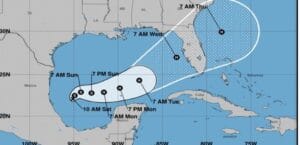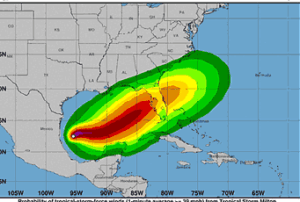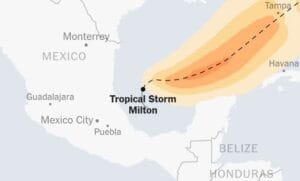Hey there, folks! It’s that time of year again when the Atlantic decides to remind us who’s boss. Tropical Storm Milton is currently making waves—literally—and it’s gearing up to possibly become a major hurricane before it hits Florida. If you’re in the Sunshine State or have loved ones there, it’s crucial to stay informed and prepared. Let’s dive into what’s happening with Milton and how you can stay safe.
Current Status of Tropical Storm Milton
Location and Wind Speed
As of the latest updates, Tropical Storm Milton is swirling several hundred miles east of Florida, packing winds that are already clocking in at 60 miles per hour. Not exactly a gentle breeze! Meteorologists are keeping a close eye on this storm, and things are looking like they could escalate quickly.
Forecast Strengthening
The waters of the Gulf Stream are warm right now, which can be like a power-up for storms. With the right conditions, Milton could transition from a tropical storm to a hurricane—and potentially a major hurricane—within the next couple of days. That’s why it’s essential to stay alert; this storm has the potential to change rapidly.
Path and Predictions
Projected Trajectory
So, where is Milton headed? Current forecasts suggest a northwest trajectory, which means Florida is squarely in its sights. However, predicting a storm’s exact path can be tricky—think of it like trying to guess which way a dog will chase a squirrel. The storm could make landfall anywhere along Florida’s central coast, and even areas like Orlando and Cape Canaveral are on high alert.
Areas of Concern
While meteorologists are honing in on potential landfall areas, it’s important for residents across the state to stay informed. Just because your town isn’t in the immediate path doesn’t mean you’re out of the woods. Weather patterns can shift, and it’s best to be prepared for anything.
Potential Impacts of the Storm
Wind Damage
Should Milton strengthen into a hurricane, wind speeds could surpass 100 miles per hour. That’s no joke! Such winds can uproot trees, knock down power lines, and even cause structural damage. If you live in a vulnerable area, consider securing outdoor furniture and other items that could become projectiles.
Rainfall and Flooding
Rainfall is another concern. Meteorologists are predicting that some areas could see 6 to 12 inches of rain, leading to flash flooding, especially in low-lying regions. If you’ve ever tried to drive through a flooded street, you know it’s not just dangerous; it can also be life-threatening.
Storm Surge Threat
Coastal areas should also be bracing for storm surge. This phenomenon occurs when the sea level rises due to strong winds and low pressure. For many coastal communities, this can lead to severe flooding. If you live near the coast, make sure to know your evacuation routes and have a plan in place.
Tornado Risk
And let’s not forget about the potential for tornadoes! Hurricanes can spawn tornadoes in their outer bands, and these can occur far from the center of the storm. Stay vigilant, especially if you hear tornado warnings.
Preparations Underway
State and Local Responses
In response to Milton’s approach, state and local officials are gearing up. Emergency services are on high alert, and local governments are communicating with residents about safety measures and evacuation plans.
Emergency Services on Alert
Fire departments, police, and rescue services are preparing to respond to emergencies as they arise. It’s a good reminder that these brave individuals are ready to help, but the first step in your safety lies with you.
Evacuation Plans
If you’re in an area that might be evacuated, it’s critical to know your options. Don’t wait for the last minute to figure out where you’ll go if an evacuation order is given. Plan ahead!
The Role of Technology in Storm Tracking
Satellite and Radar Innovations
Technology plays a huge role in how we track storms today. Satellite imagery and radar systems give meteorologists real-time data, allowing for timely updates and warnings. This means more accurate forecasts and, hopefully, more lives saved.
Importance of Social Media and Apps
Social media and mobile apps have become essential for staying updated during storms. Local authorities use these platforms to share vital information quickly. It’s a good idea to follow local news and government accounts to ensure you’re receiving the latest alerts.
Community Resilience and Preparedness
Importance of Community Support
In times of crisis, community support is vital. Local organizations often step up to help residents prepare for storms, providing resources, emergency kits, and advice. If you can, lend a hand to your neighbors who might need it.
Resources for Residents
Many resources are available for residents preparing for storms. From government websites to local shelters, make sure you know where to find help if needed. Knowledge is power when it comes to storm preparedness!
Staying Informed
Official Sources of Information
Always rely on official sources for storm information. The National Hurricane Center and local meteorological services provide the most accurate and up-to-date data.
Importance of Following Updates
Storms can change quickly, so it’s important to stay on top of updates. Don’t let misinformation from social media lead you astray—trust the experts.
How AI is Transforming Business Operations in Q3: A Comprehensive Analysis
FAQs
1. What should I include in my emergency kit?
- Your emergency kit should include water, non-perishable food, medications, a flashlight, batteries, first aid supplies, and important documents.
2. How can I stay updated on the storm’s progress?
- Follow the National Hurricane Center and local weather channels for real-time updates. Social media can also be useful, but verify information from official sources.
3. What areas in Florida are most at risk?
- While all coastal areas should prepare, central Florida, including Orlando and Cape Canaveral, are currently in the storm’s projected path.
4. Should I evacuate if I live near the coast?
- If evacuation orders are given, it’s crucial to follow them. Always have a plan and know your evacuation routes ahead of time.
5. How can I help my community during a storm?
- Consider volunteering with local organizations that provide support and resources. Also, check on your neighbors, especially the elderly or those with disabilities, to see if they need assistance.


